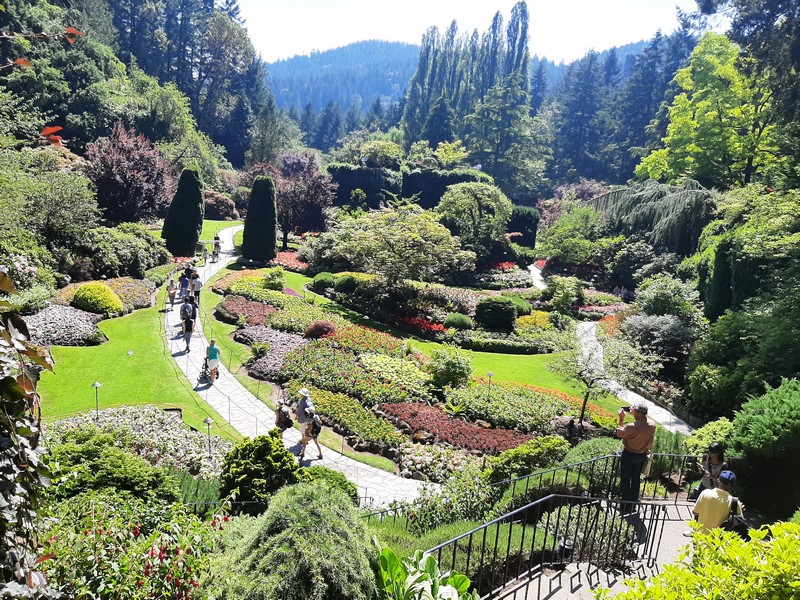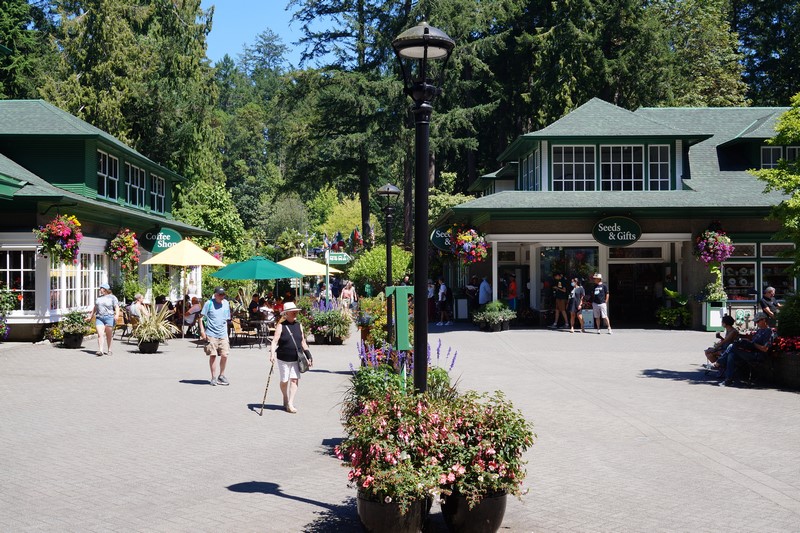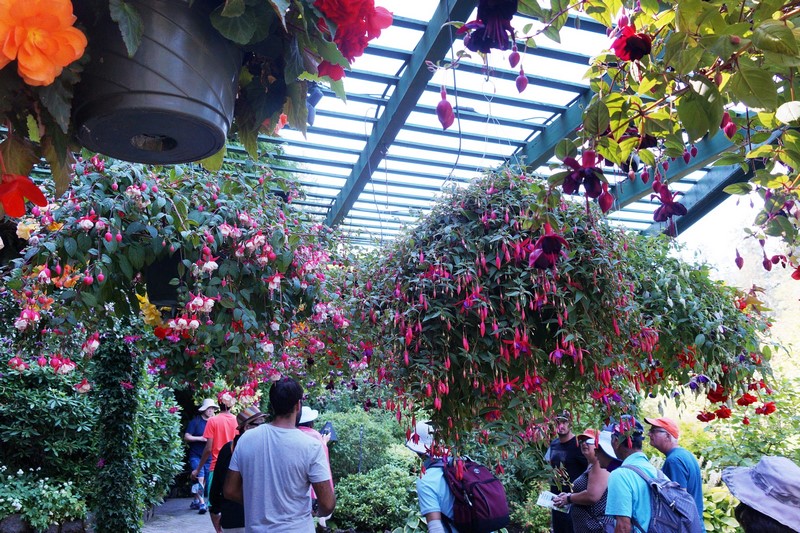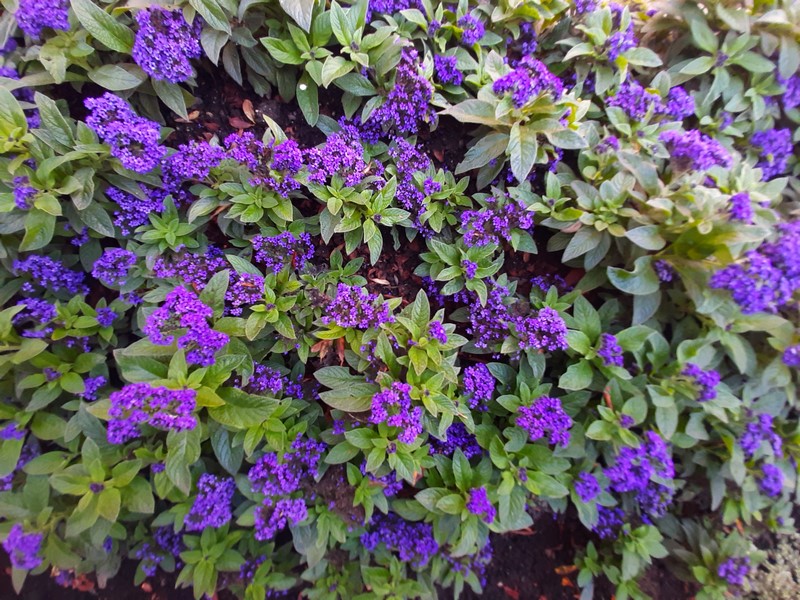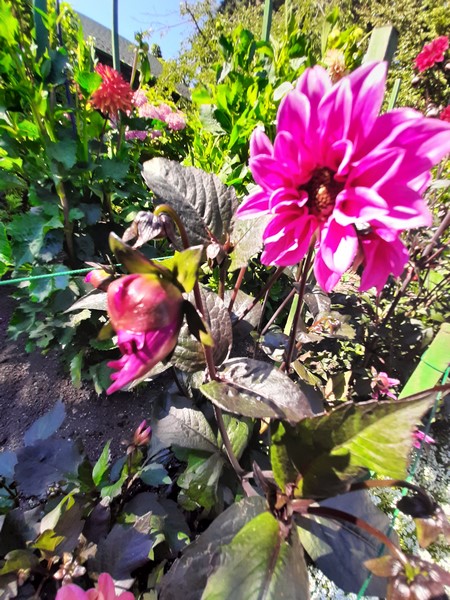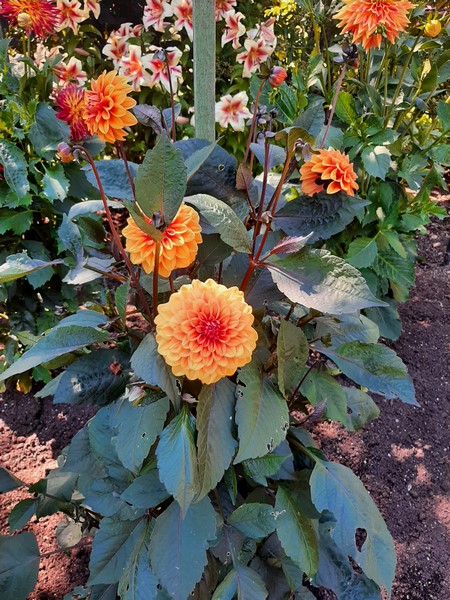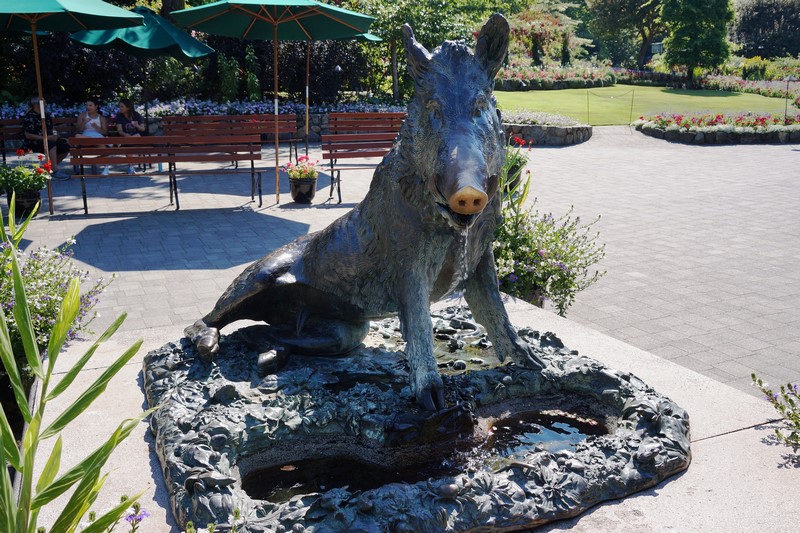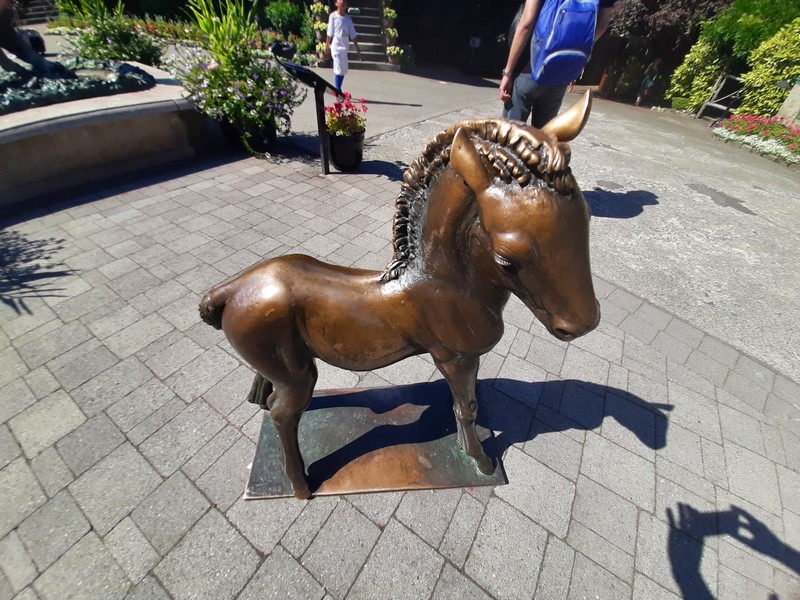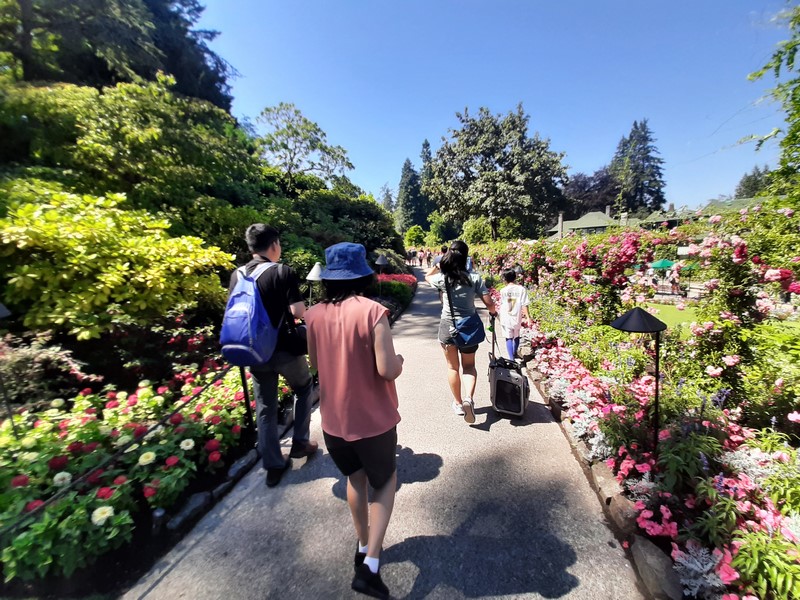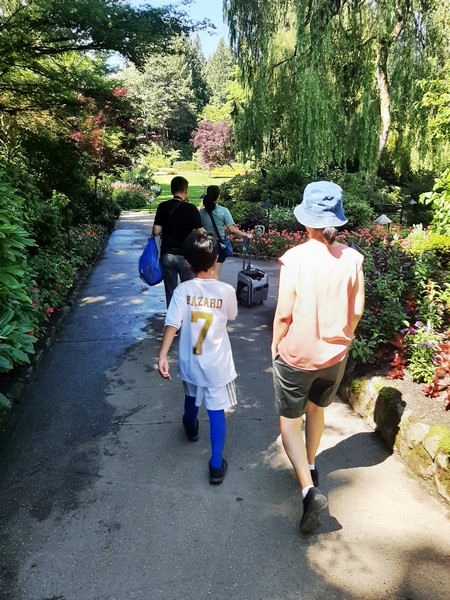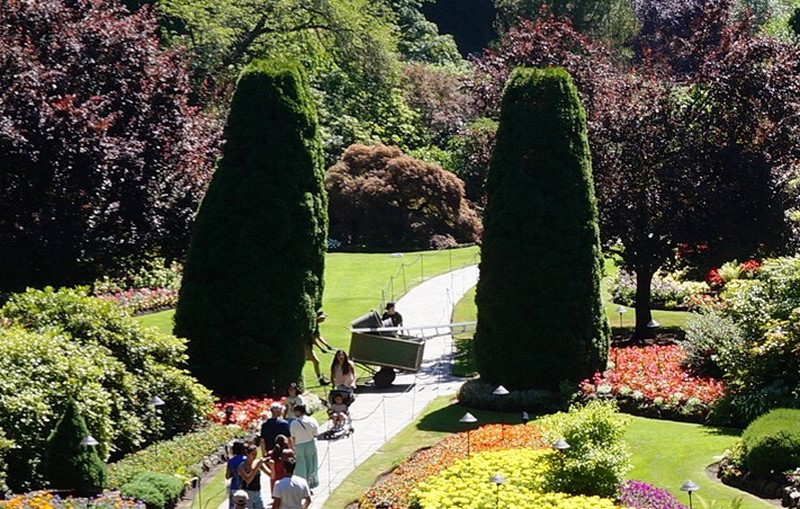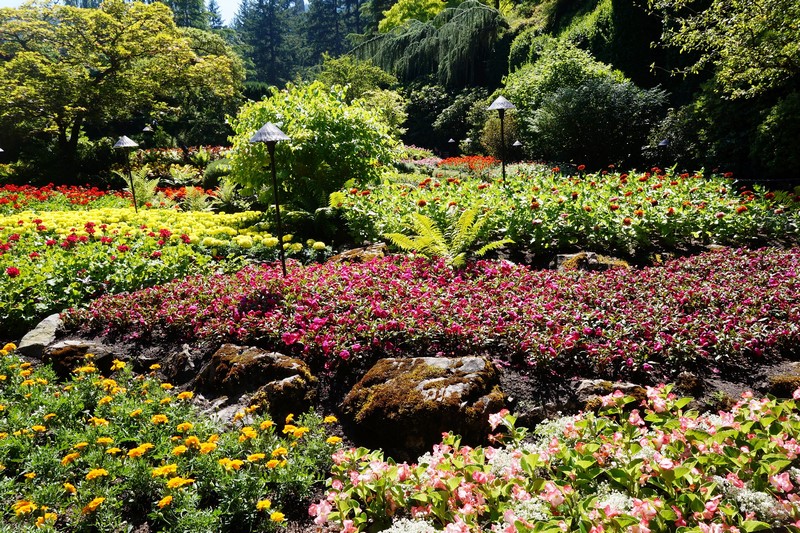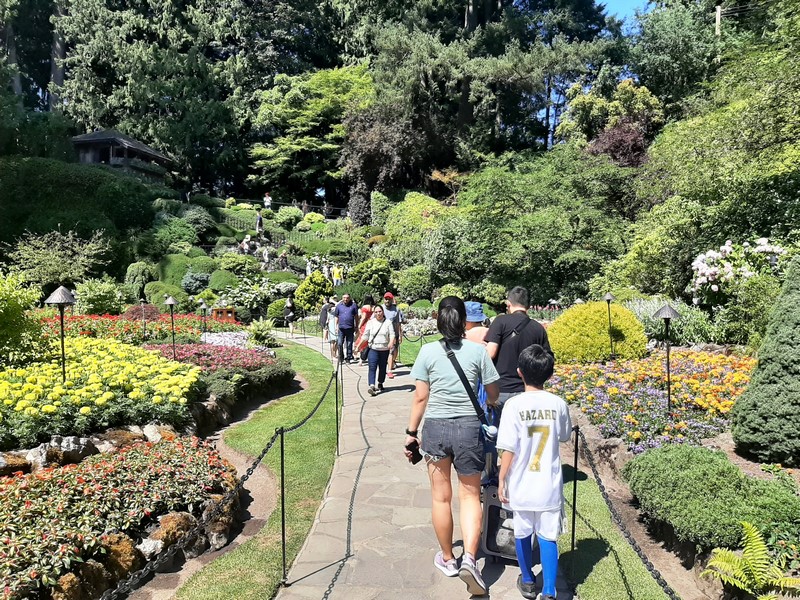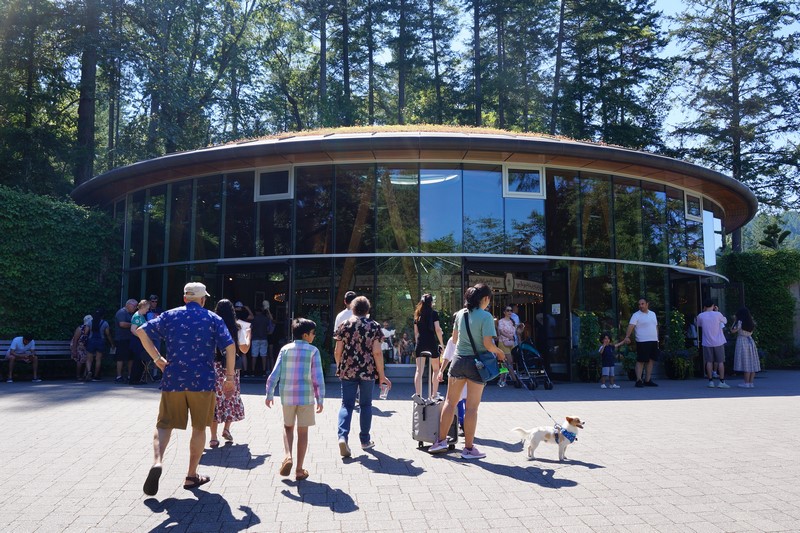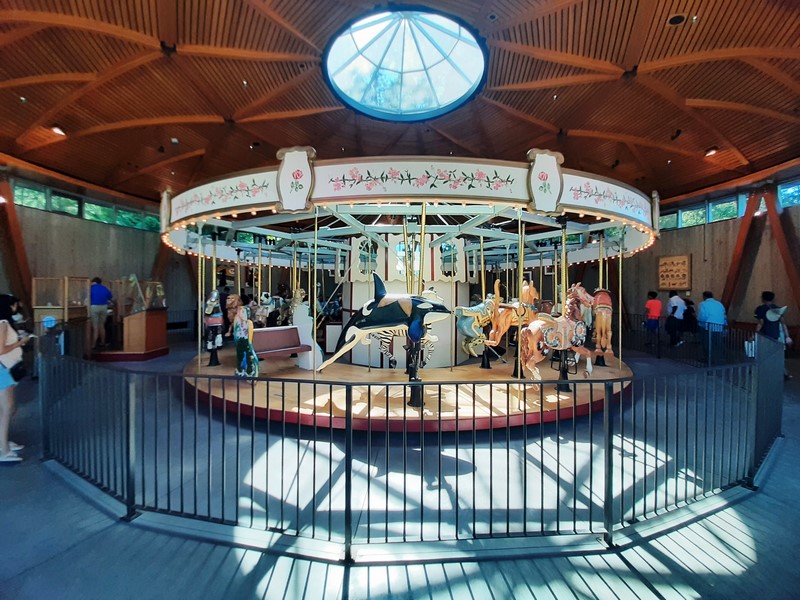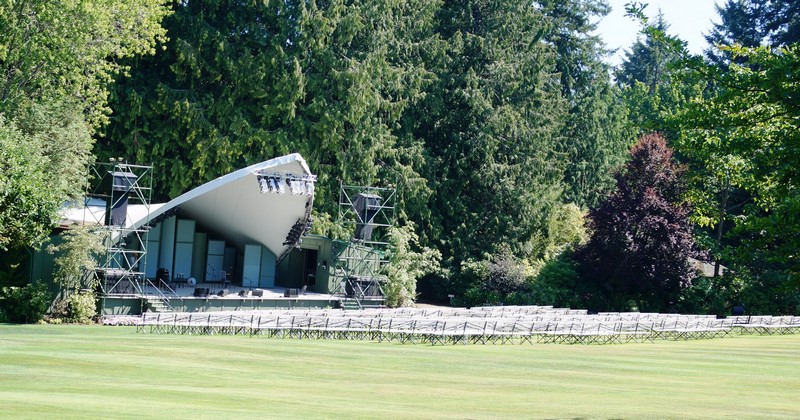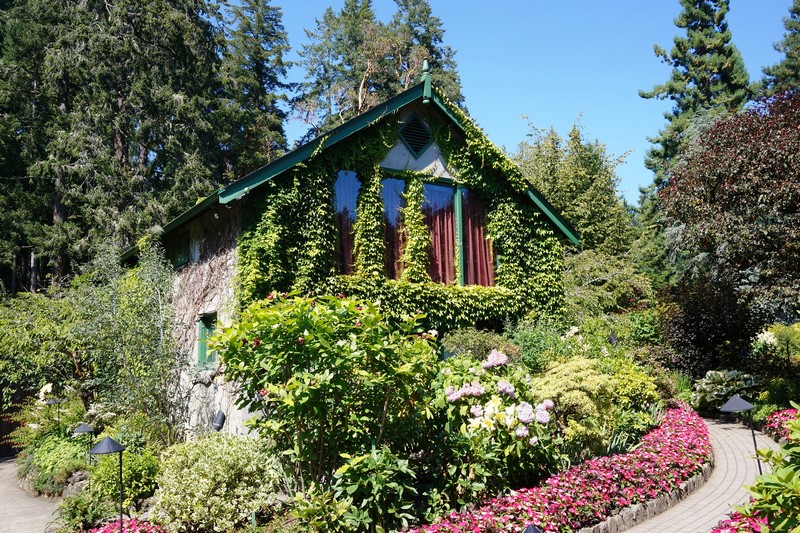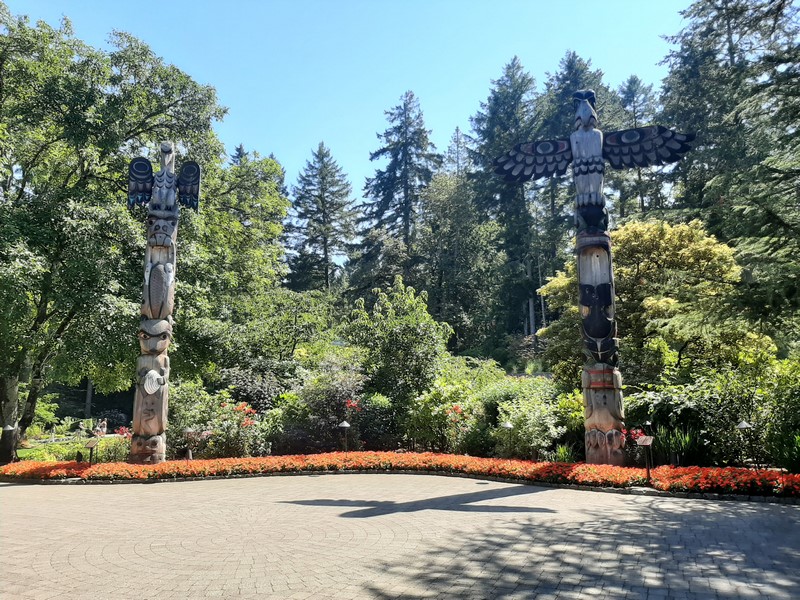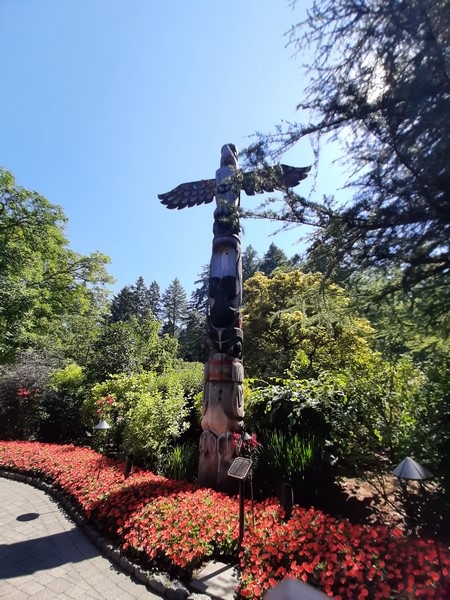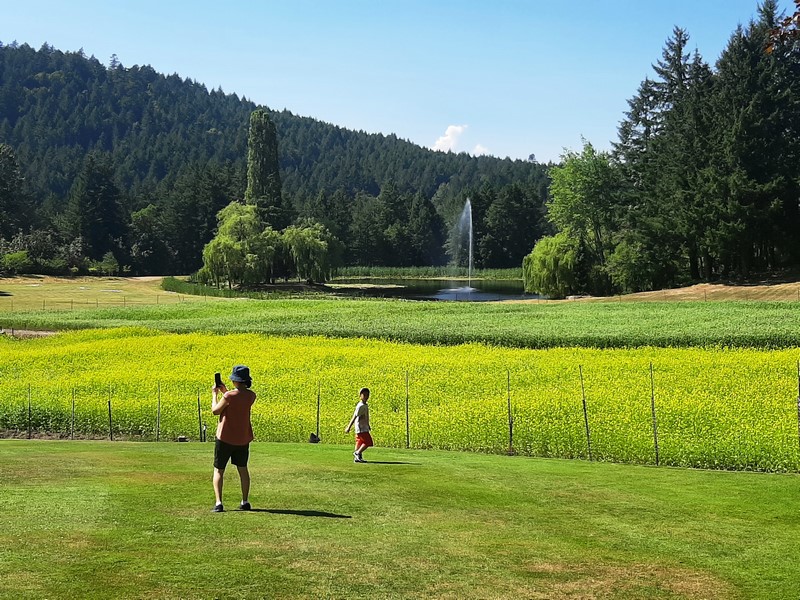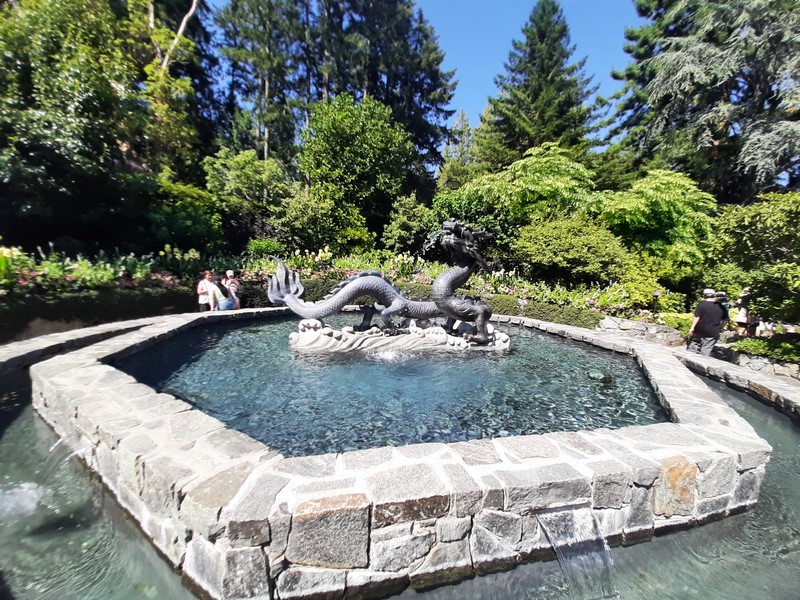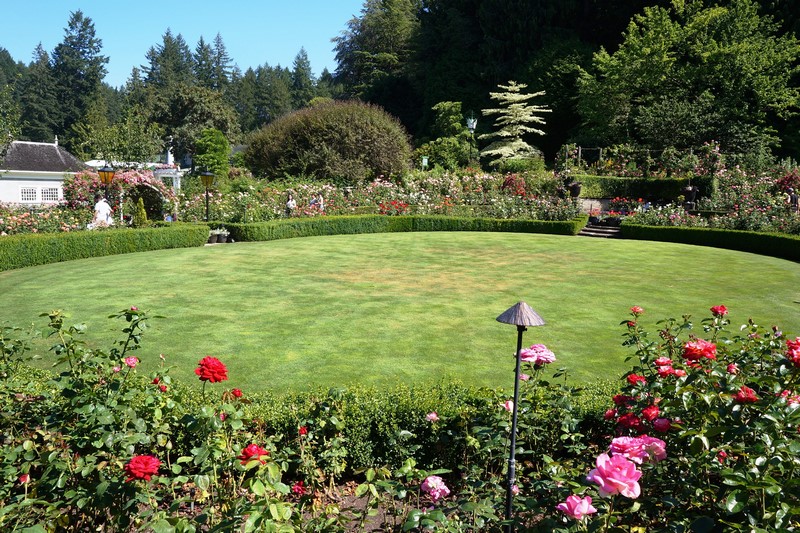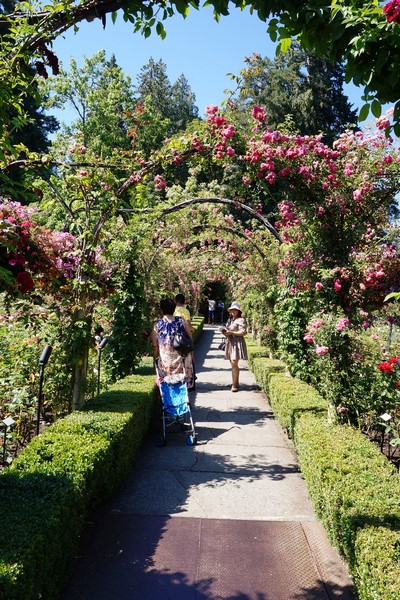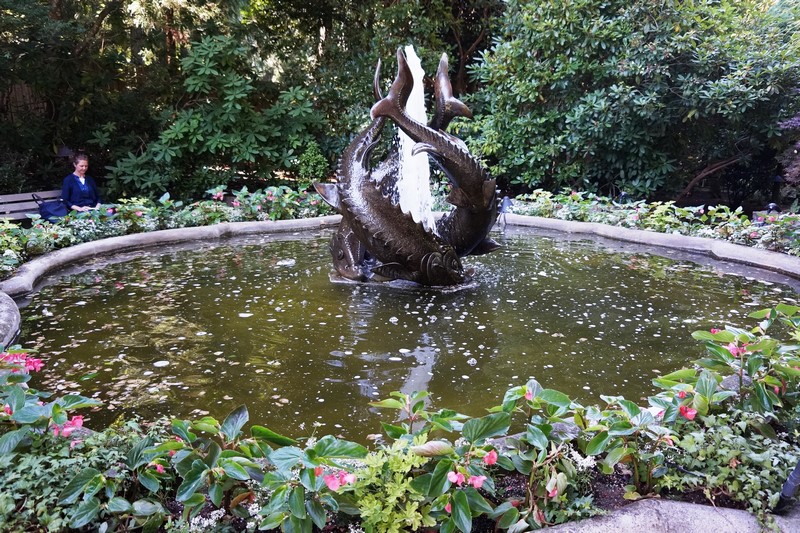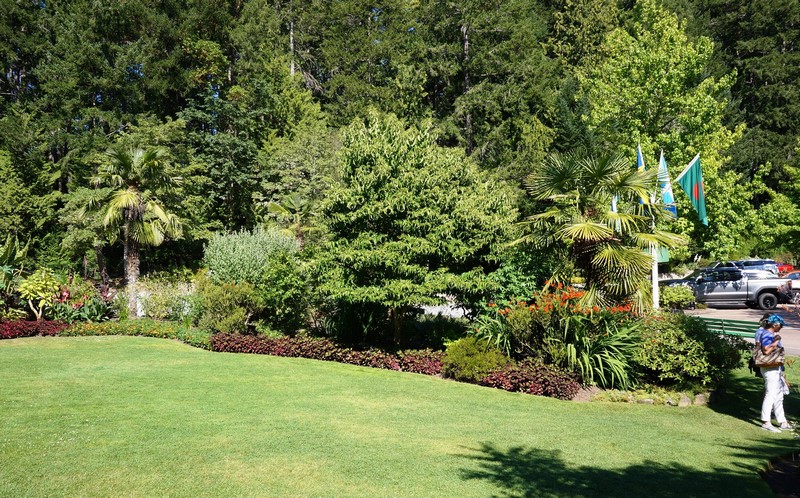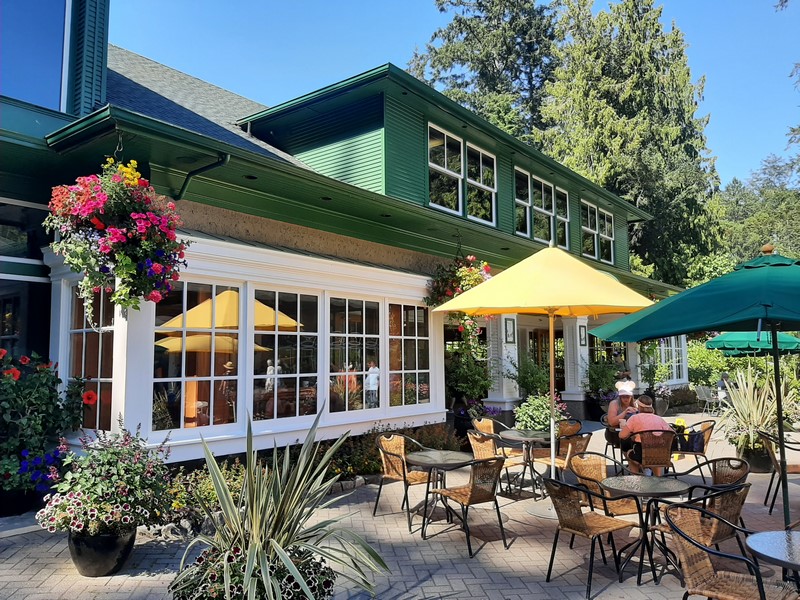From Swartz Bay Ferry Terminal, Grace, Jandy, Cheska, Kyle and I, with our dog Luffy, rode on a double-decker Bus 72 (we missed the direct, one-hour Bus 81), operated by Victoria Regional Transit System, for the nearly 40-min. drive to Saanichton then transferred to a single-deck Bus 75 for the nearly 30-min. drive to get to the world-renowned Butchart Gardens, an absolute must see when traveling to Victoria.
The lush, 22.3-hectare (55-acre) Butchart Gardens, a group of floral display gardens, located on the Saanich Peninsula, near Victoria on Vancouver Island, has delighted visitors from all around the world with its over a million awe-inspiring bedding blooms (in some 900 varieties) and unique plantings, receiving over a million visitors each year.
It is consistently rated among the world’s most beautiful garden attractions and top places to go to in Canada by USA Today, CNN Travel, Condé Nast, National Geographic, Tripadvisor and Frommer’s and more.
Started by Robert Pim Butchart (1856–1943) and his wife Jennie Butchart (1866–1950), ownership of The Gardens still remains within the Butchart family and, since 2001, the owner and managing director is Robin-Lee Clarke, the Butcharts’ great-granddaughter.
Here is the historical timeline of the gardens:
- In 1888, Robert Pim Butchartbegan manufacturing Portland cement near his birthplace of Owen Sound, Ontario, Canada. He and his wife Jennie Butchart came to the west coast of Canada because of its rich limestone deposits necessary for cement production.
- In 1904, they established their home near his quarry on Tod Inlet at the base of the Saanich Peninsulaon Vancouver Island.
- In 1908, the Bucharts named their home “Benvenuto” (“welcome” in Italian)
- In 1909, when the limestone quarry was exhausted, Jennie wanted to recreate some natural beauty from the remains of her husband’s mined-out industrial quarry site so she set about turning it into the Sunken Garden, transferring top soil by horse and cart. She commissioned Isaburo Kishida, a 67 year-old garden designer from Yokohama, Japan (he built a wildly popular tea gardenfor Esquimalt Gorge Park in 1907) before he returned to Japan in 1912.
- In 1921, the Sunken Garden was completed and they began to receive visitors to their gardens.
- In 1926, they replaced their tennis courts with an Italian garden
- In 1929, the Bucharts replaced their kitchen vegetable garden with a large rose garden to the design of Butler Sturtevantof Seattle. Samuel Maclure, who was consultant to the Butchart Gardens, reflected the aesthetic of the English Arts and Crafts Movement.
- In 1939, they gave the Gardens to their grandson Robert Ian Ross (1918–1997) on his 21st birthday. Ross was involved in the operation and promotion of the gardens until his death 58 years later.
- In 1946, Ann-Lee Ross, Robert Ian Ross’ wife, opened the Benvenuto Tea House (now called the Dining Room) and continued the tradition of serving afternoon teato guests.
- In 1953, to mark the 50th anniversary of The Gardens, miles of underground wiring were laid to provide night illumination.
- In 1964, the ever-changing Ross Fountain was installed in the lower reservoir to celebrate the 60th anniversary.
- In 1977, during summer Saturday evenings, Christopher Ross (1944–2000), Robert Ian Ross’s son, introduced firework shows accompanied by show tunes, choreographing them until his death in 2000.
- In 1982, the Butchart Gardens was used as the inspiration for the gardens at the Canadianpavilion opened at Epcot Centre in Orlando Florida.
- In 1993, to commemorate their 50th wedding anniversary, the “Circle of Doves,” given by Ann-Lee Ross to her husband Ian in 1991, was installed in front of the Begonia Bower.
- In 1994, the Canadian Heraldic Authoritygranted a coat of arms to the Butchart Gardens.
- On September 9, 2004, two totem poles were installed and dedicated to mark the 100th anniversary.
- That same year, The Gardens were designated as a National Historic Site of Canada.
- In the summer of 2008, The Gardens introduced the Jennie B, an electrically driven 12-passenger boat, which plies the local coastlines in the summer giving visitors an appreciation of the waterside history plus coastal aquatic plants and animals.
- On December 1, 2009 the Children’s Pavilion and the Rose (or Menagerie) Carousel were opened to the public.
While Jennie Butchart collected plants, Robert Pim Butchart collected ornamental birds from all over the world (he had a parrot in the house, ducks in the Star Pond and peacocks on the front lawn). Robert also built several elaborate birdhouses for the gardens and trained pigeons on the site of the present-day Begonia Bower.
In the early days, Mr. and Mrs. Butchart often hosted weekly symphony concerts for guests of the family but, later, attracted a larger audience. More recently, during the summer season (July and August) and the winter holiday season, they provide a wide range of local entertainment, from jazz to classical music.
Also, The Weeds (a band made up of staff members from The Gardens) sometimes plays during the summer season, During winter, lights and seasonal decorations adorn the gardens along with an ice-skating rink in the Waterwheel Square.
Upon payment of the admission fee, we were ushered into Waterwheel Square, our starting point, which was aptly named after a lovely waterwheel beside the entrance. The statue of a wild boar, in the heart of the square, was cast in Florence by Ferdinando Marinelli Artistic Foundry and purchased in 1973 during a family trip to Italy and installed the next year.
The snout of this replica of the Cinghiale, a 1620 marble statue (displayed in the Uffizi Gallery in Florence) by Pietro Tacca (in honor of the sculptor, it is called “Tacca”) is, just like the original, shiny from the many visitors rubbing it for good luck. In front of the residence is another nearby statue, by Sirio Tofanari, of a donkey and foal.
Check out “Uffizi Gallery”
Buchart Gardens encompasses five separate gardens: the Sunken Gardens, the Rose Garden, the Japanese Garden, the Italian garden and the Mediterranean Garden. To keep these gardens looking impeccable, they have 26 greenhouses and employ 50 full-time gardeners, 12 part-time gardeners as well as 550 staff during peak season. With regards irrigation supply, the gardens are entirely self-sufficient as, every year, millions of liters of rainwater are collected, via runoff, from the parking lots and stored in a number of reservoirs and wells.
From the flower-lined Laurel Walk, a pathway on the left led to the Begonia Bower which was overflowing with hanging baskets of begonias and fuchsias. Designed in 1917 by Samuel Maclure as a “Chinaman’s Cottage,” it was later renamed the Gardener’s Cottage, circa 1950.
Past the Laurel Walk is the top of “the Mound,” a massive limestone rock embankment (designed by Raoul Robillard) rising, above the switch back stairs, from the center of the iconic, 5-acre Sunken Gardens, the crown jewel of the Butchart Gardens.
Flanking the main path are an iconic pair of Thuja occidentalis Fastigiata trees (Arbor vitae), commonly called the “tree of life,” planted by Jennie in 1930 (they are now on their third pair). The Mound has spectacular views of the garden including the tall chimney of the long vanished kiln. To the left of the cement stack are six Lombardy poplars (Populas nigra italica) planted by Jennie in 1910 to hide the cement factory.
Once a pile of rock and rubble, the quiet and peaceful Sunken Garden is, as the name suggests, located below road level. The first land reclamation project in the world, the garden, dotted with benches, boasts 151 flower beds, 65,000 bulbs planted for spring and cradles an impressive assortment of flowers, trees and shrubs.
A path, from here, winds past the undulating and spectacular Ross Fountain, installed in 1964 by Robert Ian Ross (Jennie and Robert’s grandson) to celebrate the 60th anniversary of The Butchart Gardens. The fountain is surrounded by a rotating selection of seasonal blooms.
In summer, during The Gardens Night Illuminations displays, it comes alive as magical lighting effects dance across its waters. Another path leads to the serene pond of the Bog Garden which is surrounded by weeping-willows.
From the Sunken Garden, a path led us, half-way through The Gardens, to the 700 sq. m. (7,500 sq. ft.) Children’s Pavilion, which has a dome with a 23-m. (75 ft.) clear span, a full-fronted glass façade and a roof planted with native plant species. It also has an event room for such things as children’s birthday parties. Annabelle, the elegant bronze carousel horse sculpted by Nathan Scott, is located next to the pavilion.
Housed within is the popular Rose (or Menagerie) Carousel, the only carousel on Vancouver Island. The carousel was crafted by Brass Ring Entertainment of Sun Valley, California. The brightly painted and hand-carved wooden menagerie, mirroring the world from which The Gardens draws its visitors, includes thirty animals ranging from bears, to horses, to ostriches, to zebras, to cats.
In consultation with an artist from North Carolina, Robin Clarke (the gardens’ owner and great-granddaughter of Jennie Butchart) handpicked the design of each animal carving. Done by some of the few remaining carvers of carousel art, they were carved from basswood and took many months to complete. There are also two chariots able to accommodate disabled persons. Kyle didn’t want to miss out on the carousel so, accompanied by Jandy, tried it out ($2 per person).
Across from the pavilion is the Concert Lawn and Stage. Here, between 1953 and 1967, the Victoria Symphony Orchestra (conducted by Hans Gruber), under the sponsorship of Mr. and Mrs. Ian Ross, performed summer concerts on the main lawn. The concerts also featured many international artists such as Teresa Stratas, Bernard Turgeon and Grace Bumbry. On occasion, guest conductors were also invited to lead the orchestra.
Nearby is the Organ Pavilion, the original dairy barn which now houses the Aeolian Pipe Organ played at The Butchart Gardens. Fully playable manually, this organ boasts just under one thousand individual pipes, a set of twenty tubular chimes and a forty-nine note percussive harp.
Located on a back path behind the Concert Lawn are tallest of two California redwoods (Sequioia sempervirens) which were planted as seedlings Afred Shiner, former Head Gardener, in 1934.
Another path led us to two 9.1 m. (30-ft.) high and 1.2-m. (4-ft.) wide totem poles dedicated on September 9, 2004 in celebration of the 100th anniversary of The Butchart Gardens, they are a recognition of the rich cultural heritage provided by the First Nations peoples.
The “Eagle with Salmon, Orca, Bear with Salmon” was carved in Contemporary Coast Salish style by master carver Doug LaFortune of the Tsawout First Nation while the “Raven, Beaver with Grouse, Otter with Pups & Clam, Frog” was carved in Classic Coast Salish style by master carver Charles Elliot of the Tsartlip Nation.
Nearby is the Seed and Fireworks Field. The land here was purchased in 1903 from Mr. Fernie, a local dairy farmer. In 1969, a reservoir was excavated to ensure a water supply for irrigation and a single jet fountain was installed to aerate the water supply in the largest reservoir. Today, the fountain is now the focal point of a fireworks display.
On our way to the Rose Gardens, we passed by the striking bronze Dragons Fountain, the newest addition to The Gardens. A gift from Suzhou (Victoria’s sister city) and the People’s Republic in China in 2015, at night, color-changing LED lights create beautiful scenes in the waters of this peaceful fountain.
The vibrant Rose Garden, in the center of the grounds, brims with an impressive collection of seven types and at least 280 varieties of roses. From summer to early fall, this heavenly scented garden bursts to life with 2,500 rose plants.
The 30 arches, intertwined with large sprays of rambler, floribunda, climber and hybrid tea roses, is a favorite spot for a stroll.
On our way to the Japanese Gardens, we passed by the Fountain of the Three Sturgeons, once the location of a large Japanese teahouse. This bronze fountain of three dancing sturgeon, purchased in 1973, is the first casting (by the Ferdinando Marinelli Artistic Foundry) from the enlargement of a work created by Sirio Tofanari in 1958. Visitors often sit on the surrounding benches and enjoy the tranquil sounds of the fountain.
A torii gate, marked the entrance, to the quiet, 1-acre Japanese Garden. The gate is flanked, on each side, by magnificent purple European copper beech (Fagus sylvatica purpurea) planted in 1906. The first of Jennie Butchart’s formal gardens, it was started in 1906. In her design, Jennie was assisted by 67 year-old, Japanese landscape artist Isaburo Kishida. Under the supervision of Hugh Lindsay (the first of Mrs. Buchart’s head gardeners), laborers from the cement works implemented Kishida’s plan.
A scenic relaxation sanctuary, it is home to 500 rhododendrons and azaleas, 74 Japanese maple trees (Acer palmatum dissectum), moss-covered grounds as well as 200 m. of trickling streams. The European beech trees and Japanese maple trees (at the head of the stone stairs leading down to the garden) are the oldest non-native trees in the Buchart Gardens. Himalayan Blue Poppies blossom in the spring.
From the Japanese Garden, a path led us to the fantastic, 21,780 sq. ft. Italian Garden. Once the Butchart family’s tennis court, it was designed by famous architect Samuel Maclure and completed in 1929. The garden is home to 22,000 bulbs and biennials as well as 18 flower beds and 85 varieties of plants.
Two beautiful, flower-studded ponds are also located here – the Star Pond (originally designed for Mr. Butchart’s collection of live ornamental ducks) and a sophisticated, cross-shaped pond. Bronze statues and the nearby Gelateria Benvenuto bring a taste of Italy to the grounds.
We almost missed the diminutive and quaint, 21,780 sq. ft. Mediterranean Garden which was hidden near the parking lot. A homage to Vancouver Island’s Mediterranean climate, it hosts an array of 110 varieties of exotic plants (in 9 garden beds), ranging from electric-blue delphinium to massive-leafed banana plants and one awe-inspiring agave plant.
The food and beverage outlets within The Gardens are the Coffee Shop (salted caramel mocha; Oh Canada latte; fresh, house-made shortbread cookie; etc.), The Dining Room Restaurant, Gelateria Benvenuto in the Italian Garden (12 locally-inspired flavors of ice-cold gelato) and the cafeteria-style Blue Poppy Restaurant.
Buchart Gardens: 800 Benvenuto Ave., Brentwood Bay, near Victoria, British Columbia V8M 1J8. E-mail: email@butchartgardens.com. Website: www.buchartgardens.com. Open daily, 11:30 AM to 3:30 PM (up to 10 PM during summer, June 15 to September 3). Tel: +1 250-652-4422. Coordinates: 48°33′55″N 123°28′10″W.
Admission (including tax):
- Spring 2022 (April 1–June 14): CAD 35.40 (adults, 18 + years old), CAD 17.70 (youth, 13–17 years old) and CAD 2.00 (child, 5–12 years old)
- Summer 2022 (June 15–September 30): CAD 38.00 (adults, 18 + years old), CAD 19.00 (youth, 13–17 years old) and CAD 3.00 (child, 5–12 years old)
- Fall 2022 (October 1–October 31): CAD 31.80 (adults, 18 + years old), CAD 15.90 (youth, 13–17 years old) and CAD 2.00 (child, 5–12 years old)
- November 1–November 30: CAD 24.75 (adults, 18 + years old), CAD 12.40 (youth, 13–17 years old) and CAD 2.00 (child, 5–12 years old)
- Christmas 2022 (December 1–January 6): CAD 34.00 (adults, 18 + years old), CAD 17.00 (youth, 13–17 years old) and CAD 3.00 (child, 5–12 years old).

